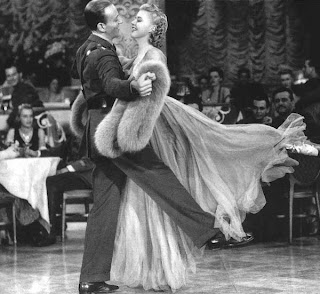 |
| Glamor icon Ginger Rogers portrays former glamor icon Irene Castle in the only biopic she and Fred did together. |
Before Fred and Ginger became America's dancing sweethearts, that title was held by Vernon and Irene Castle. Dancing during the 1910s until Vernon's tragic death in an airplane crash, the Castles popularized many of the different social dances of the era including the tango and the foxtrot, and their celebrity status was unmatched in their day. In fact Irene Castle became such a fashion icon that practically everything she wore became a fad--as Connie Willis notes in her hilarious study of fads and the herd mentality Bellwether
Largely fictional like most biopics of the day, this film shows how Vernon and Irene met, their rise to stardom, and Vernon's death in a freak plane crash during World War I--that isn't a spoiler; it's historical fact. That's right, folks, you've found the only film out there that dares to kill Fred Astaire.
So why isn't this film fondly remembered by Astaire and Rogers fans? Well, if the ending of the last paragraph didn't make one reason abundantly clear, there's a lot of ways in which it's different from the others they made together. And in straying from that formula, the film loses its charm. For one thing Fred Astaire and his best friend Hermes Pan, who had done all the choreography for the other movies, were stellar and meticulous choreographers, but their influence was restrained in this film do to the fact that they were re-creating other people's work. Secondly, there were no original songs for this film, thus it's the only Fred and Ginger film of the '30s that did not introduce a Jazz standard. While these are the two most important elements, I also think it's important to note that it lacks the Art Deco elegance and the fun boy-chases-girl plot structure that people loved from earlier films too.
Because of these elements, I almost never watch this movie, and really had to study it before my review. One thing I will say is that the supporting cast is strong with Walter Brennan and Edna May Oliver leading it up. Like it's predecessor Carefree however, this film lacks the corps of actors that re-appear in the earlier films, which means that we lose the pleasure that we get of seeing the familiar faces in the other ones. Interestingly enough, we see a scary echo of WWI and a vision of WWII near the end of the film when Vernon, a British citizen, joins the RAF. While countless British soldiers are dying in the trenches of Flanders, Vernon Castle pleads in vain for the Americans to join the war. The irony is that this movie was released in 1939, at the outbreak of WWII where once again Britain would be in dark and desperate straits and once again America would be tragically late joining the fight (Continental Europe completely overrun, and 30,000 civilians killed in the London Blitz, to say nothing of the millions of Jews who lost their lives to the Holocaust).
There's something plaintively tearful about this movie in another way too. Not only does it mark the end of an era for Astaire and Rogers, but it doesn't even send us out with a bang. Instead of reminding us of all the great films that came before it, instead of one last hurrah for the witty banter, the inspired songs of Irving Berlin, Gershwin, and Jerome Kern, and the fabulous dancing of Fred and Ginger, we're left with our favorite dancing duo effacing themselves by doing other people's dances and pointing back at the horror of a conflict past while reminding us of the trials still to come. The innocence of the other films has been lost forever--they are as dead as Vernon/Fred is at the end of the picture, and the final shadowy images of Fred and Ginger dancing into the background as Ginger weeps for her lost love only serve to enforce the feeling of bereavement.
I give this movie a 6.9. It's the lowest score for any film which stars Fred and Ginger, but I still think that fans of the duo should see it.
No comments:
Post a Comment